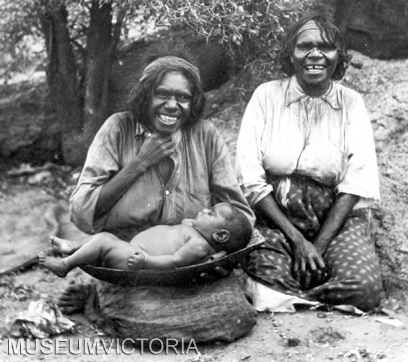Two Arrente Women with a baby

The fundamental feature of the social organisation of the Arrente, and of the majority of Aboriginal tribes, is the division of the society 'into two exogamous intermarrying groups'.(1 These two social groups, or moieties, are, in the Arrente tribe, each subdivided into two, or even four, sections, or what Spencer initially referred to as classes. The whole classificatory system and social organisation is based upon the existence of these exogamous intermarrying groups, and in association with them there is a series of terms used that are expressive of the relationship that exists between each individual and every other member of the tribe. The fundamental feature of the terms used is that they are indicative of group relationship and only sometimes, in a secondary way, of individual relationship. Therefore an Arrente man calls a large number of men belonging to one particular group by the name 'OLYCU' (a term which includes our relationship of father) ... he calls all the wives of these men by the common name of 'Mid (mother) and ... he calls all their sons by the name of 'Okilia' (elder brother) or 'Itia' (younger brother)... All the 'fathers' are men who belong to the particular group to which his own actual father belongs; all the 'mothers' belong to the same group as that to which his actual mother belongs, and all the 'brothers' belong to his own group. (4 Marriages are usually established according to the custom whereby every Arrente woman is made Tualcha mura to a man. (5 The arrangement, which is often a mutual one, is made between two men, and it will be seen that, owing to a girl being made Tualchu muru to a boy of her own age, the men very frequently have wives much younger than themselves, as the husband and the mother of a wife obtained in this way are usually of approximately the same age. When it has been agreed upon between two men that the relationship shall be established between their two children, one a boy and the other a girl, the two latter, who are generally of a tender age, are taken to the Lukwurra or women's camp, and here each mother takes the other's child and rubs it all over with a mixture of fat and red ochre in the presence of all the other women, who have assembled for the purpose of watching the ceremony... The arrangement is, of course, only made between boys and girls who stand in a definite relationship to one another. The girl must be one who is Muru to the boy - that is, one whose daughters belong to the section from which his wife must come - but whilst, in common with all the women of her particular section, she is already Muru to him, she now becomes Tudchu muru - that is, she is his actual or prospective mother-in-law. This relationship indicates that the man has the right to take as wife the daughter of the woman; she is, in fact, assigned to him, and this, as a general rule, many years before she is born. (6 Spencer stresses that the relationship between one Aboriginal person and another is one of the most important points with which each individual must be acquainted. There are certain customs which are enforced by long usage and according-to which men and women of particular degrees of relationship may alone have marital relations, or may not speak to one another, or according to which one individual has to do certain things for another, such as providing the latter with food or with hair, as the case may be, and any breach of these customs is severely punished. (7
(1 'The Arunta', p 41
(2 Ibid. pp 41-2
(3 Ibid. p 44
(4 'The Native Tribes of Central Australia', p 56
(5 'The Arunta', p 469
(6 Ibid. pp 469-70
(7 'The Native Tribes of Central Australia', pp 67-8
(1 'The Arunta', p 41
(2 Ibid. pp 41-2
(3 Ibid. p 44
(4 'The Native Tribes of Central Australia', p 56
(5 'The Arunta', p 469
(6 Ibid. pp 469-70
(7 'The Native Tribes of Central Australia', pp 67-8
Keywords: aborigines, anthropology, Arrente, Baldwin Spencer, Walter, Central Australia, custom, Northern Territory, 1895
Photograph: Two Arrente women with a baby. Alice Springs, 1895. Photograph Baldwin Spencer. Reproduced courtesy Museum Victoria.
Author: Rowse, Tim and Graham, Trevor
© Museum Victoria
Author: Rowse, Tim and Graham, Trevor
© Museum Victoria
